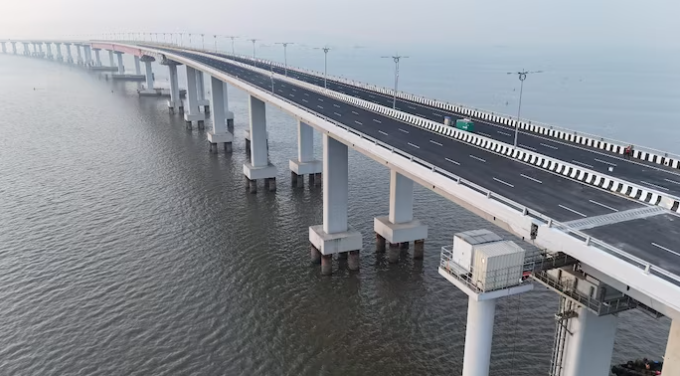Atal Setu Bridge in Mumbai: Key Features and Benefits (GS Paper 3, Economic Development)

Introduction
- The Atal Setu Bridge, also known as the Mumbai Trans Harbour Link (MTHL), is a monumental infrastructure project that has transformed connectivity in Mumbai.
- Inaugurated by Prime Minister Narendra Modi on January 12, 2024, this bridge stands as India's longest sea bridge, connecting Mumbai to Navi Mumbai and significantly reducing travel time between these two important regions.
Recent Controversy
- Despite the successful inauguration, the Atal Setu Bridge recently faced scrutiny due to cracks that emerged on an exit road near Navi Mumbai.
- Opposition leaders alleged corruption and poor construction practices.
- However, authorities have clarified that the cracks are minor and restricted to a connecting road, not affecting the main bridge structure itself.
- This clarification has aimed to assure the public and maintain confidence in the bridge's integrity.
Overview of Atal Setu Bridge
- Status: Longest sea bridge in India
- Global Ranking: 12th longest sea bridge in the world
- Budget Outlay: ₹17,840 crore
- Foundation Stone Laid: December 2016
- Dimensions: 21.8 km six-lane bridge (16.5 km sea, 5.5 km land)
- Expected Daily Traffic: Almost 70,000 vehicles
- Expected Lifespan: 100 years
- Toll Charges: ₹250 one-way for cars
Key Features of Atal Setu
- Cost and Length: Constructed at a cost of over ₹17,840 crore, the Atal Setu spans 21.8 kilometers, combining a 16.5 km stretch over the sea with approximately 5.5 km on solid ground.
- Connectivity: Strategically enhances connectivity between Mumbai Port and Jawaharlal Nehru Port, facilitating faster access to Mumbai International Airport and Navi Mumbai International Airport.
- Reduced Travel Time: Aims to transform the current two-hour journey from Mumbai to Pune, Goa, and South India into a swift 15-20 minute commute.
- Historical Significance: Originally conceptualized six decades ago, Atal Setu fulfills its primary objective by linking Mumbai’s Sewri with Raigad’s Chirle, marking a historic milestone in India’s infrastructure development.
- Maximum Speed Limit: The Mumbai Trans Harbour Link sets a maximum speed limit of 100 kmph for four-wheelers, ensuring efficient and swift transportation.
Mumbai Trans Harbour Link (MTHL) Technologies
- Reverse Circulation Drilling (RCD) Piling: RCD is an innovative technology used for the first time in India for pile foundation laying. It minimizes noise disturbances compared to traditional vertical drilling methods.
- Orthotropic Steel Deck (OSD) Bridge Girders: OSD is a construction method that combines strength and flexibility. This technology allows the bridge’s steel deck to withstand heavy loads, such as vehicles, while maintaining a lightweight structure.
- Open Road Tolling (ORT) System: MTHL became the first project in the country to adopt the ORT method of collecting tolls. This system allows toll collection without requiring vehicles to stop or slow down, enhancing efficiency.
Benefits of Atal Setu
- Reduced Travel Time: According to a study conducted by the Mumbai Metropolitan Region Development Authority (MMRDA) and the Japan International Cooperation Agency (JICA), the MTHL is expected to bring down the average travel time between Sewri and Chirle from 61 minutes to less than 16 minutes.
- Increased Vehicle Usage: Close to 40,000 vehicles are expected to use the link every day in the opening year (2024).
- Economic Integration: The project is expected to facilitate greater economic integration of Navi Mumbai with Mumbai, with benefits extending to areas like Panvel, Alibaug, Pune, and Goa.
- Improved Connectivity: The bridge reduces the distance between Mumbai and Pune Expressway, enhancing overall connectivity in the region.
Environmental and Technological Measures
- All-weather Design: The bridge is designed to withstand various weather conditions, ensuring year-round usability.
- Lightning Protection: Equipped with advanced lightning protection systems to safeguard the structure and users.
- Noise Barriers: Installed to minimize noise pollution, enhancing the environmental quality for nearby areas.
- Environmental Protection: Special measures have been taken to protect the flamingo habitat and the nearby Bhabha Atomic Research Centre.
Conclusion
- The Atal Setu Bridge is a landmark infrastructure project that symbolizes India's progress and commitment to enhancing connectivity.
- Despite minor controversies, the bridge's benefits far outweigh the challenges, making it a critical link between Mumbai and Navi Mumbai.
- With its advanced technologies, significant cost savings, and substantial reduction in travel time, the Atal Setu Bridge is poised to play a pivotal role in the region's economic and infrastructural development.


